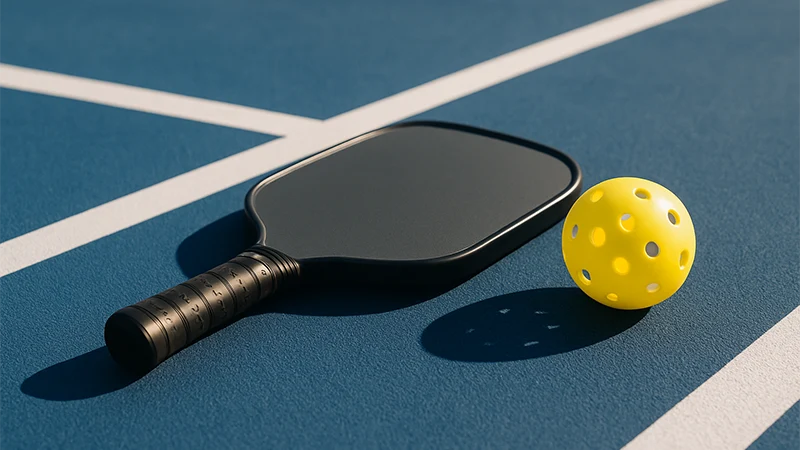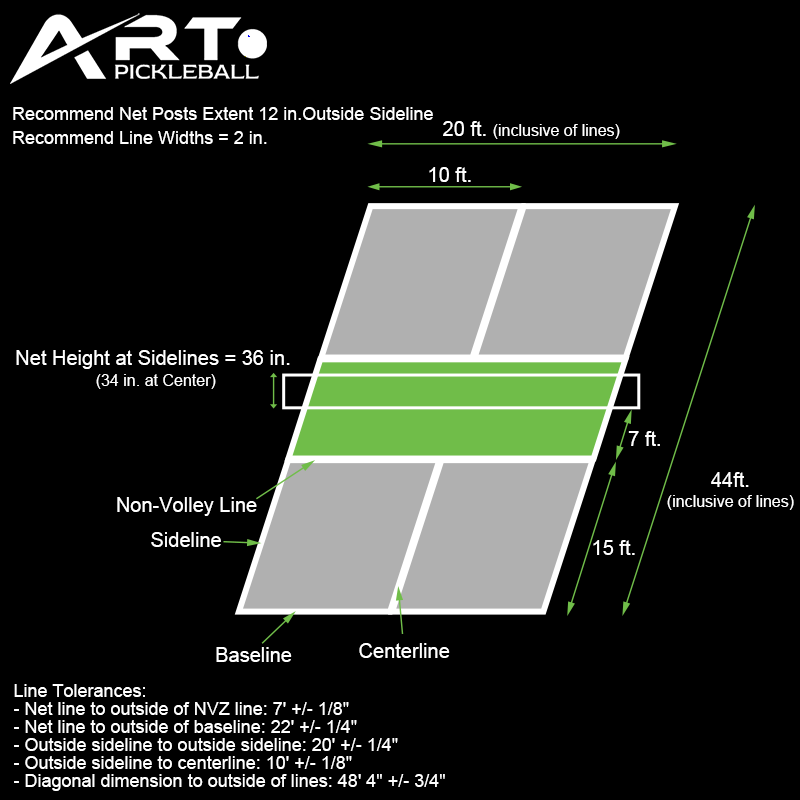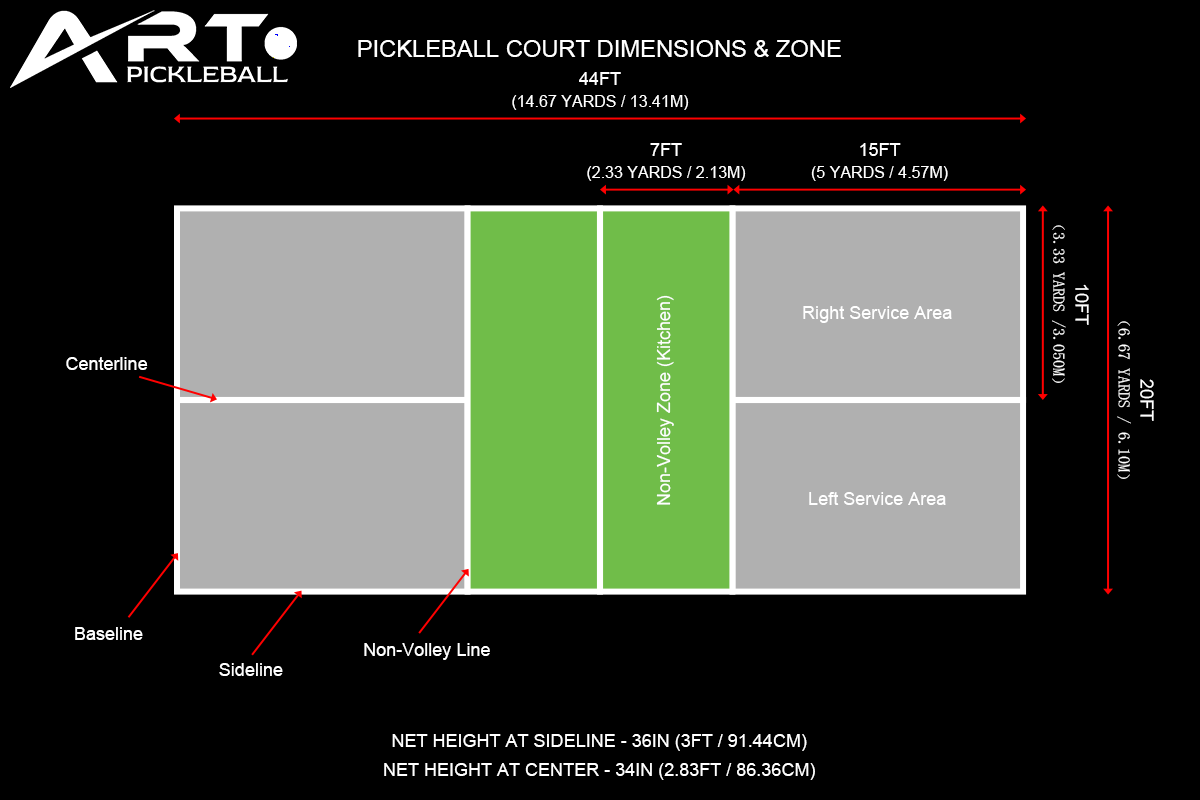The Complete Guide to Pickleball Court Dimensions

CEO & Technical Expert at Pickleball Equipment Company (Art Pickleball)
Specialize in manufacturing pickleball paddles, pickleball balls, and pickleball accessories.

Pickleball has quickly become one of the fastest growing sports in the United States and around the world. Whether you are a beginner just picking up a paddle or a facility manager planning to build new courts, one of the first questions you will ask is simple: What are the official pickleball court dimensions?
The size of the court matters more than most players realize. It affects how rallies play out, the amount of space you need for movement, and even how safe and enjoyable the game feels. Many new players also wonder: Is the court different for singles and doubles? How big is a pickleball court compared to tennis or badminton?
In this complete guide, we will break down everything you need to know about pickleball court size in feet and meters. You will learn the official dimensions, the layout of each zone including the non-volley area (kitchen), recommended playing area beyond the lines, net specifications, indoor vs outdoor surfaces, and even DIY tips for setting up your own backyard court.
What Are the Dimensions of a Pickleball Court? (Official Standards)

The official pickleball court dimensions are 20 feet wide by 44 feet long. In metric units, that equals 6.10 meters by 13.41 meters. One important detail that often surprises new players is that the court size is the same for both singles and doubles. Unlike tennis, you do not add or remove space depending on how many people are on the court.
The pickleball net spans the full 22-foot width of the court. It measures 36 inches high at the sidelines and 34 inches high at the center, which creates a slight dip in the middle. This lower center height encourages longer rallies and makes pickleball easier for players of all ages.
Court lines are included in the measurements. Each line should be 2 inches wide, usually painted white or another contrasting color so players can clearly see boundaries. The lines count as “in,” so if the ball touches any part of them, the shot is considered good.
To put it in perspective, the entire pickleball court covers 880 square feet, which is less than one-third the size of a tennis court. This compact design is one reason pickleball is so accessible. It allows people to build multiple courts in the space of one tennis court and makes the game faster paced while still easy on the body.
If you want a quick summary, here are the official pickleball court dimensions:
| Measurement | Feet | Meters |
|---|---|---|
| Court length | 44 ft | 13.41 m |
| Court width | 20 ft | 6.10 m |
| Net height at center | 34 in | 0.86 m |
| Net height at sidelines | 36 in | 0.91 m |
| Non-volley zone (kitchen) | 7 ft from net | 2.13 m |
| Line width | 2 in | 5 cm |
These numbers form the foundation of every pickleball match, from backyard play to professional tournaments. Getting them right ensures fairness, consistency, and compliance with official standards published by USA Pickleball.
Pickleball Court Zones Explained

A pickleball court is more than just a rectangle with a net. It’s designed with specific zones, and each one has a role that shapes the way the game is played. Knowing these zones helps you follow the rules, position better, and avoid unnecessary mistakes.
Baseline and Sidelines
The baseline runs parallel to the net at the back of the court. Players must serve from behind this line, and stepping on it during the serve is a fault. The sidelines mark the left and right boundaries. Together, the baselines and sidelines define the outer edges of the pickleball court size.
Non-Volley Zone (Kitchen)
The most famous part of the court is the non-volley zone, also called the kitchen. It extends 7 feet from the net on both sides. While standing inside this zone, a player cannot hit the ball out of the air. This rule prevents players from camping at the net and smashing every shot, keeping rallies longer and more strategic. A common beginner mistake is stepping on the kitchen line while volleying, which also counts as a fault.
Centerline
Each side of the court is divided in half by the centerline, which runs from the non-volley zone line to the baseline. This line separates the left and right service areas. When serving, you must aim diagonally into your opponent’s service court across the centerline.
Service Courts
There are two service courts on each side: the left service court and the right service court. Each measures 10 by 15 feet. Players alternate serves from right to left, and the ball must land in the correct diagonal service box for the serve to be valid.
Line Width and Visibility
All court lines are 2 inches wide and count as “in” if the ball touches them. For visibility, lines are usually painted in white or another color that contrasts strongly with the surface.
Quick Summary of Court Zones
- Baseline: back boundary of the court.
- Sidelines: left and right boundaries.
- Non-volley zone (kitchen): 7 ft area near the net where volleys are not allowed.
- Centerline: splits each side into two service courts.
- Service courts: left and right boxes where serves must land.
These court zones are the foundation of every pickleball rally. Knowing them helps players avoid faults, position themselves correctly, and build strategies around the unique features of pickleball, especially the kitchen.
Playing Area Beyond the Lines (Safety & Comfort)
When most people think about pickleball court dimensions, they only focus on the 20 by 44 feet playing surface. But in reality, you need more room than the lines alone provide. Extra space around the court is critical for safe movement, comfortable rallies, and an overall better playing experience.
Minimum and Recommended Playing Area
According to official guidelines, the minimum recommended total area for one pickleball court is 30 feet wide by 60 feet long. This allows for about 5 feet of clearance on each sideline and 8 to 10 feet behind each baseline. For competitive play and multi-court facilities, the ideal recommended size is 34 feet wide by 64 feet long. This gives players more breathing room and reduces the risk of running into fences, walls, or other players.
Why Extra Space Matters
Pickleball involves quick reactions and constant movement. Players often chase lobs or stretch for wide shots, which means they need space beyond the marked lines. Without proper run-off areas, rallies can become unsafe and frustrating. The added space also makes room for benches, bags, and spectator seating, which is especially important in clubs and tournaments.
Comparing Court Size vs. Playing Area
| Layout Type | Court Lines Only | Minimum Recommended | Ideal Recommended |
|---|---|---|---|
| Width | 20 ft (6.10 m) | 30 ft (9.14 m) | 34 ft (10.36 m) |
| Length | 44 ft (13.41 m) | 60 ft (18.29 m) | 64 ft (19.51 m) |
| Clearance | None | 5 ft sides / 8–10 ft baselines | More space for safety and comfort |
Practical Considerations
If you are planning to build or convert a court, always account for this additional space. A backyard DIY court may be playable with the minimum 30×60 feet, while a dedicated facility should aim for the full 34×64 feet to meet tournament standards. Adding this buffer not only keeps the game safe but also makes the environment more enjoyable for players of all skill levels.
Pickleball Net Specifications
A pickleball court is not complete without the right net. The net plays a critical role in how rallies develop and is one of the first things players notice when stepping onto a court. Unlike tennis, the pickleball net is slightly lower in the middle, which encourages longer rallies and makes the game more accessible.
What Is the Height and Width of a Pickleball Net? (Official Standards)
The net stretches the full 22-foot width of the court. By rule, the net must measure 36 inches high at each sideline and 34 inches high at the center. This two-inch dip in the middle is intentional, helping keep the ball in play while still allowing for strategic net shots.
Construction and Materials
Most pickleball nets are made of durable mesh with a heavy-duty cord or steel cable running along the top. The upper edge is usually reinforced with a 2-inch white band, which increases visibility and ensures consistent tension. Side posts are placed just outside the sidelines, typically a few inches beyond the 20-foot court width, so they do not interfere with play.
Portable vs Permanent Nets
Portable pickleball nets are lightweight and easy to set up, making them popular for driveways, gyms, and multi-use facilities. They often come with a wheeled base or carry bag.
Permanent pickleball nets are installed with fixed posts, usually in outdoor parks or dedicated clubs. These nets maintain tension better over time and meet professional standards for tournaments.
Common Mistakes to Avoid
One of the most frequent errors in DIY courts is setting the net too high, often because people reuse an old tennis net. A tennis net is 42 inches at the posts and 36 inches at the center, which is much higher than pickleball standards. Always measure carefully to ensure the correct pickleball net height.
Court Surface & Indoor vs Outdoor Differences
The surface of a pickleball court has a big impact on how the game feels. From ball bounce to player safety, the choice of materials can make the difference between a casual setup and a professional-grade court. While the official court dimensions never change, indoor and outdoor surfaces often do.
Common Pickleball Court Surfaces
Asphalt or Concrete: The most popular base materials for outdoor courts. These are durable, low maintenance, and cost effective. They are often finished with an acrylic sports coating that adds color, traction, and weather resistance.
Acrylic Sports Coating: Applied on top of asphalt or concrete, this textured surface improves grip and ball consistency. It also reduces glare and can be customized in different colors.
Wooden Gym Floors: Common indoors, especially in multi-use facilities. While smooth and comfortable underfoot, wood may produce slightly faster ball speeds compared to acrylic coatings.
Modular Tiles: Snap-together plastic tiles are used in gyms or temporary spaces. They provide excellent traction, shock absorption, and can be installed without permanent construction.
Indoor Pickleball Courts
Indoor courts are typically found in gyms, community centers, or converted warehouses. They use wood floors, rubberized sports flooring, or modular plastic tiles. Indoor environments eliminate weather concerns like wind and rain, which means more predictable ball flight. However, lighting and ceiling height become important factors in competitive play.
Outdoor Pickleball Courts
Outdoor courts are often built on asphalt or concrete with an acrylic finish. They need to withstand temperature changes, UV rays, and moisture. Outdoor pickleballs are slightly heavier and have smaller holes than indoor balls, which helps them resist wind. Players should also consider fencing, drainage, and shaded areas when building outdoor courts.
How to Choose the Best Surface for Your Needs
Backyard or DIY courts: Portable nets and modular tiles are the simplest option.
Community parks: Asphalt with acrylic coating provides durability and low upkeep.
Competitive facilities: Dedicated acrylic-coated courts on concrete bases meet professional standards.
Pickleball vs Other Sports Courts
One of the easiest ways to understand pickleball court dimensions is to compare them with other sports. Since pickleball is often played on converted tennis or badminton courts, many players naturally ask: Is a pickleball court the same size as a tennis court or a badminton court? The answer is no.
Pickleball vs Tennis Court
A standard pickleball court measures 20 by 44 feet, while a tennis doubles court is 36 by 78 feet. That means a tennis court is more than three times larger in total area. Because of this, one tennis court can fit up to four pickleball courts when properly laid out. This difference explains why pickleball feels faster paced but requires less running than tennis.
Pickleball vs Badminton Court
Interestingly, the dimensions of a pickleball court are almost identical to a badminton doubles court. Both are 20 feet wide and 44 feet long. The main difference is the net height and the addition of the non-volley zone (kitchen) in pickleball. This similarity is one reason why many gyms that already have badminton courts can easily transition to pickleball.
Court Size Comparison Table
| Comparison Item | Pickleball Court | Tennis Court (Doubles) | Badminton Court (Doubles) |
|---|---|---|---|
| Court Length | 44 ft (13.41 m) | 78 ft (23.77 m) | 44 ft (13.41 m) |
| Court Width | 20 ft (6.10 m) | 36 ft (10.97 m) | 20 ft (6.10 m) |
| Net Height (Center) | 34 in (0.86 m) | 36 in (0.91 m) | 60 in (1.55 m) |
| Net Height (Sideline) | 36 in (0.91 m) | 42 in (1.07 m) | 60 in (1.55 m) |
| Non-Volley Zone | 7 ft (2.13 m) from net | None | None |
| Service Area Width | 10 ft (3.05 m) | 13.5 ft (4.11 m) | 10 ft (3.05 m) |
| Service Area Length | 15 ft (4.57 m) | 21 ft (6.40 m) | 22 ft (6.70 m) |
| Total Playing Area | 880 sq ft | 2,808 sq ft | 880 sq ft |
| Special Features | Kitchen zone, smaller net | Larger baseline, faster pace | Higher net, designed for shuttlecock |
Key Takeaway:
- A pickleball court is one-fourth the size of a tennis court.
- A pickleball court is the same size as a badminton doubles court, but with different rules and net specifications.
- This smaller footprint makes pickleball easier to set up in parks, gyms, and backyards while still delivering an exciting and competitive game.
Multi-Court Layouts & Tennis Court Conversion
Pickleball is often played in shared spaces, especially in parks and clubs where tennis courts already exist. Since a tennis court is much larger than a pickleball court, many people ask: How many pickleball courts fit on a tennis court? The answer depends on whether you are setting up a temporary layout or doing a full conversion.
How Many Pickleball Courts Fit on a Tennis Court?
A regulation tennis court measures 36 feet wide by 78 feet long for doubles play. In comparison, a pickleball court is only 20 by 44 feet. This size difference allows you to fit up to four pickleball courts within the footprint of one tennis court. The most common layouts are:
- Two pickleball courts placed side by side, using the existing tennis net line as a divider.
- Four pickleball courts laid out in a grid pattern, which maximizes space but requires portable nets or permanent re-striping.
Temporary vs Permanent Conversions
Temporary Conversion: Many facilities simply tape or chalk pickleball lines over the existing tennis surface. Players then use portable pickleball nets. This is cost effective and allows the court to switch back to tennis when needed.
Permanent Conversion: For dedicated pickleball facilities, tennis courts can be resurfaced and re-striped with permanent pickleball lines. Permanent posts and nets are installed, and the old tennis lines are often removed or painted over in a lighter color to avoid confusion.
Multi-Court Layout Considerations
When placing multiple pickleball courts in the same space, it is important to maintain enough buffer between courts. Ideally, leave 8 to 10 feet between the baselines of adjacent courts and at least 5 feet between sidelines. This spacing improves safety and allows players to move freely without interference from nearby games.
Advantages of Tennis Court Conversion
- Maximizes use of existing facilities.
- Provides an affordable way to meet the growing demand for pickleball courts.
- Allows clubs to attract both tennis and pickleball players without building new structures.
DIY Pickleball Court Setup: Step-by-Step Guide
Not every player has access to a dedicated facility, which is why so many people search for ways to build a pickleball court at home. The good news is that you can create a playable backyard pickleball court or convert an existing space like a driveway, parking lot, or gym floor with just a few tools and careful measurements.
Step 1: Choose the Location
- Find a flat, hard surface such as asphalt, concrete, or a smooth driveway.
- Make sure you have at least 30 by 60 feet of space, even though the actual court lines are 20 by 44 feet.
- Check for overhead clearance if indoors (minimum 18–20 feet recommended).
Step 2: Gather Your Materials
- Measuring tape (at least 50 feet)
- Chalk, painter’s tape, or temporary marking tape
- Straight edge or string line
- Pickleball net (portable or permanent)
- Optional: paint and stencils for permanent lines
Step 3: Mark the Baselines and Sidelines
- Mark a rectangle 20 feet wide by 44 feet long.
- Use tape or chalk to create straight, visible lines.
- Remember: each line should be 2 inches wide, and the lines are included in the court dimensions.
Step 4: Add the Non-Volley Zone (Kitchen)
- Measure 7 feet from the net on each side.
- Draw a line parallel to the net across the full 20-foot width.
- This creates the non-volley zone, or kitchen, where volleys are not allowed.
Step 5: Add the Centerline and Service Courts
- Divide each side of the court into two equal service boxes.
- Draw a centerline from the kitchen line to the baseline.
- Now you have left and right service areas, each measuring 10 by 15 feet.
Step 6: Set Up the Net
- Place a pickleball net that is 22 feet wide across the middle of the court.
- Adjust the height: 36 inches at the sidelines, 34 inches at the center.
- Portable nets are the easiest option for DIY courts.
Step 7: Test and Adjust
- Play a few rallies to ensure the markings and net are correct.
- If permanent, go over the taped lines with paint for durability.
- Double check the measurements before making anything permanent.
Tips for a Successful DIY Court
- Use temporary court marking kits if you want flexibility.
- Always measure diagonals to ensure the court is square.
- Avoid building too close to walls or fences; leave run-off space for safety.
- If you are in a backyard, consider noise and lighting for evening play.
Advanced Considerations for Clubs & Builders
Building a professional pickleball facility requires more than just drawing lines on a surface. Clubs, schools, and community centers must think about long-term durability, player safety, and compliance with official tournament standards. Below are the most important factors to consider when planning advanced pickleball court construction.
Court Orientation
For outdoor courts, orientation matters. Courts are typically aligned north–south to reduce sun glare during morning and evening play. This is especially important for facilities hosting competitive matches, where visibility can directly impact performance.
Drainage and Surface Grading
Proper drainage prevents water accumulation and surface damage. Courts should be built with a slope of 1% (about 1 inch per 8–10 feet) to allow rainwater to run off. Without this, puddles can create unsafe playing conditions and shorten the life of the surface.
Lighting for Night Play
Many clubs maximize court usage with evening games, which requires quality lighting. The USA Pickleball recommendation is 30 foot-candles of light evenly distributed across the court. LED fixtures are now the standard, offering better energy efficiency and reduced glare compared to older halogen lamps.
Fencing and Court Separation
Permanent facilities should install fences or netting around courts to contain balls and protect spectators. Recommended fence height is 8 to 10 feet, with divider nets between courts when multiple are built side by side. This prevents interruptions from stray balls and gives players more focus.
Seating and Amenities
Clubs should also consider player comfort. Benches, water stations, and shaded seating areas make a big difference, especially in warmer climates. For tournaments, spectator seating and scoreboards are often added to enhance the viewing experience.
Compliance with Tournament Standards
If your facility plans to host professional or league matches, ensure courts meet USA Pickleball and IFP standards. This includes:
- Proper dimensions and run-off areas (minimum 30×60 feet per court).
- Regulation net height (34 inches at the center, 36 inches at the posts).
- Clear line markings in contrasting colors.
- Surface consistency across all courts.
Budget and Long-Term Planning
While initial costs can be significant, investing in the right materials and infrastructure reduces maintenance over time. Concrete with an acrylic sports coating is the gold standard for permanent pickleball courts. Clubs should also factor in insurance, resurfacing schedules, and potential expansion as demand grows.
Conclusion
Pickleball court dimensions may look simple, but every measurement matters. From the 20 by 44 foot playing surface to the 7 foot kitchen and the correct net height, these standards keep the game fair, safe, and enjoyable for everyone.
If you are building a court or just getting started, stick to the official rules and use our free resources to make setup easy.
Need pickleball equipment? Get in touch with us at Art Pickleball.
FAQs About Pickleball Court Dimensions
1. Is a pickleball court the same size for singles and doubles?
Yes. Unlike tennis, pickleball uses the same court size for both singles and doubles: 20 feet wide by 44 feet long.
2. How wide is the kitchen in pickleball?
The non-volley zone, also called the kitchen, extends 7 feet from the net on both sides. Players cannot volley while standing in this area.
3. How much space do you need for a pickleball court?
The official court is 20 by 44 feet, but you need at least 30 by 60 feet for safe play. For clubs and tournaments, 34 by 64 feet is recommended.
4. Can you fit pickleball courts on a tennis court?
Yes. A standard tennis court can fit up to four pickleball courts if laid out correctly with portable nets or permanent re-striping.
5. Can I build a pickleball court in my backyard?
Absolutely. As long as you have about 30 by 60 feet of space, you can create a DIY pickleball court using chalk, tape, or paint, plus a portable net.
